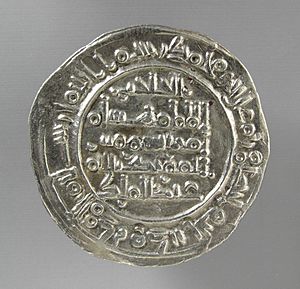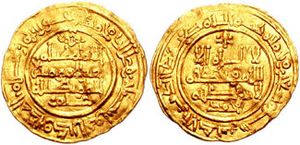Hisham II facts for kids
Quick facts for kids Hisham IIھشام المؤيد بالله |
|
|---|---|
| al-Mu'ayyad bi'llah | |

|
|
| 3rd Caliph of Córdoba | |
| 1st reign | 16 October 976 – 15 February 1009 |
| Predecessor | Al-Hakam II |
| Successor | Muhammad II |
| 2nd reign | 23 July 1010 – 19 April 1013 |
| Predecessor | Sulayman ibn al-Hakam |
| Successor | Sulayman ibn al-Hakam |
| Born | 966 Córdoba |
| Died | 19 April 1013 (aged 46–47) Córdoba |
| Father | Al-Hakam II |
| Mother | Subh |
| Religion | Islam |
Hisham II (full name: Abu'l-Walid Hisham II al-Mu'ayyad bi-llah) was an important ruler in Al-Andalus, which was the part of Spain controlled by Muslims. He was the third Umayyad Caliph (a powerful leader, like a king or emperor) of Spain. He ruled from 976 to 1009, and then again from 1010 to 1013. Hisham II was the son of Al-Hakam II and Subh of Córdoba.
Contents
Hisham II's Rule
Hisham II became the Caliph of Cordoba in 976 when he was only 10 years old. Because he was so young, he couldn't rule by himself. His mother, Subh, and a chief minister named Jafar al-Mushafi helped him. They acted as his regents, which means they ruled for him until he was old enough.
Soon, a very clever and powerful person named al-Mansur ibn Abi Aamir, also known as "Almanzor," became very influential. By 978, Almanzor had become the royal chamberlain, a high-ranking official. He worked to gain more power for himself.
In 981, Hisham II was still too young to truly lead. So, he gave most of his power to Almanzor. Almanzor then became the real ruler of the Caliphate, even though Hisham II was still officially the Caliph. Almanzor kept Hisham II almost like a prisoner for much of his reign.
Almanzor was a very successful military leader. He led many campaigns against Christian kingdoms in northern Spain. He attacked cities like Barcelona in 985 and León in 988. He even attacked the famous church of St. James in Santiago de Compostela in 998. Because of Almanzor's victories, the Caliphate of Córdoba became very strong and powerful during this time.
Changes in Leadership
Almanzor died in 1002. After him, his son, Abd al-Malik al-Muzaffar, took over as the main ruler of the Caliphate. He also led successful military campaigns until his death in 1008.
Then, another son of Almanzor, Abd al-Rahman Sanchuelo, became the leader. But in 1009, while Sanchuelo was away fighting, Muhammad II al-Mahdi took the throne from Hisham II. Hisham II was then held captive in Cordoba.
Later that same year, Muhammad II was overthrown by an army led by Sulayman ibn al-Hakam. Sulayman freed Hisham II from prison. Sulayman was then made Caliph by his army. However, Muhammad II managed to take back control in May 1010.
Finally, Hisham II was restored as Caliph by the Caliphate's Slavic troops in 1010. He ruled until 1013.
The End of Hisham II's Reign
Even after Hisham II was restored, the Caliphate was still very unstable. There was a civil war going on. In 1013, the Berbers (a group of people from North Africa) took over Cordoba. They caused a lot of damage and took many things.
What happened to Hisham II after this is not completely clear. Many believe he was killed on April 19, 1013, by the Berbers. After his disappearance, Sulayman al-Mustaʿin became the new Caliph.
Hisham II as a Symbol
After the Caliphate of Cordoba completely fell apart, many smaller kingdoms, called taifas, appeared. Because no one was sure what happened to Hisham II, some of these new kings used him as a symbol to make their rule seem more official.
For example, in 1035, the ruler of the Taifa of Seville announced that Hisham II had reappeared. He then declared his loyalty to this "returned" Hisham. Other kingdoms that were influenced by Seville did the same thing.
It wasn't until 1060 that the Sevillan ruler admitted that this supposed Hisham had actually died in 1044. But the idea that Hisham II might still be alive was a useful story for these kings. It lasted until at least 1082–83, as his name still appeared on coins from the Taifa of Zaragoza.
See also
 In Spanish: Hisham II para niños
In Spanish: Hisham II para niños
- Jacob ibn Jau


